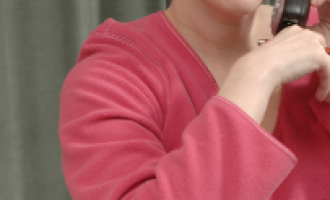
A detailed 'atlas' of neuroblastoma tumours points to a new target for immunotherapy. Scientists from the Princess Máxima Center for paediatric oncology in the Netherlands mapped this childhood tumour at the level of individual cancer and immune cells. In doing so, they discovered a brake on the immune system that can be blocked with existing immunotherapy. The results in the lab are promising; preparations for a clinical study are underway.
Every year, 25 children in the Netherlands are diagnosed with neuroblastoma, a malignant nerve tumour. Eight of the children whose disease returns after standard treatment die within five years of diagnosis. Better treatment is desperately needed.
Immunotherapy is a promising new type of treatment that targets the body’s own immune system against the tumour cells. So-called anti-GD2 immunotherapy has increased the chance of survival in children with neuroblastoma by 15% in recent years. But immunotherapy does not yet work well enough, and not yet in all children.
To better understand why immunotherapy does not always work, researchers from the Princess Máxima Center ‘mapped’ tumours of children with neuroblastoma in very high resolution. Using single-cell RNA sequencing, they analysed 24 tumours from 19 children who had been treated at the Princess Máxima Center. Single-cell RNA sequencing is a technique to study cells in a tumour – including both cancer and immune cells – at an individual level.
The research was published in the leading journal Cancer Cell. It was jointly funded by the Dutch Research Council, the Children Cancer-free Foundation and charity Villa Joep.
The scientists analysed more than 22,000 individual cells. They saw that a type of immune cell, T-cells, did not work properly in the neuroblastoma tumours. These dysfunctional T-cells also often had a protein on their surface called TIGIT. This protein puts the brake on the activity of T-cells so that they do not attack the tumour cell. An existing class of immunotherapies can switch that brake off. This class of drug, so-called checkpoint inhibitors, activates the immune system, allowing it to clear away the cancer cells.
In 3D mini-tumours, also called organoids, and in mice, the researchers saw that a combination of checkpoint inhibitors against TIGIT and another protein called PD-L1 successfully killed neuroblastoma cells. The researchers were also able to simulate recurrent neuroblastoma in mice – an aggressive form of the disease that is treated with chemotherapy and anti-GD2 immunotherapy. This experiment, too, showed that the new checkpoint inhibitor combination led to longer survival.
The drugs that block TIGIT and PD-L1 and activate the immune system, tiragolumab and atezolizumab, are already being used in studies for cancer in adults, including lung and liver cancer. The researchers are now working with the pharmaceutical company Roche to set up a clinical study for children with neuroblastoma in Europe and the US.
Dr. Judith Wienke, senior researcher in the Molenaar group at the Princess Máxima Center for pediatric oncology, who co-led the study, says:
‘In our new study, we have created a high-resolution map of the neuroblastoma immune landscape. This gives us unique insight into how the various immune cells function differently in the tumour. Our immune atlas of neuroblastoma offers important new starting points to improve immunotherapy for this type of childhood cancer.
‘Our research is still in an early phase, but the results of the new immunotherapy combination in the lab are very encouraging. The next step is to test this experimental treatment in a clinical trial. We will investigate the safety and possible benefit of the combination treatment in children with metastatic or recurrent neuroblastoma.’
Prof. Dr. Jan Molenaar, research group leader at the Princess Máxima Center for paediatric oncology, who co-led the research, says:
‘It’s fantastic that we can immediately translate the results of very basic research into the biology of neuroblastoma into the clinic – I have never experienced that translation happening so quickly before. I look forward to starting the clinical trial to ultimately see whether children with neuroblastoma will benefit from this new combination of immunotherapies.
‘Immunotherapy is being offered to increasingly many children with cancer – either as an experimental treatment or as part of the standard treatment. Basic research into the immune landscape of tumours is essential to improve the effectiveness of immunotherapy and to reduce side effects. Our research contributes to further fulfilling the promise of immunotherapy for children with neuroblastoma.’
Prof. Dr. Max van Noesel, paediatric oncologist and clinical director of solid tumours at the Princess Máxima Center for paediatric oncology, also involved in the research, says:
'In adults, checkpoint inhibitors – therapies that take the brakes off the body’s own immune system – have considerably improved the treatment of, for example, melanoma and lung cancer. But the best-known checkpoint inhibitors, which target the protein PD-L1, have not yet shown any effect in children.'
‘Thanks to the single cell approach in our study, another target, TIGIT, emerged in addition to PD-L1. The preparations for a clinical study into the effect of a combination of TIGIT and PD-L1 blockers are at an advanced stage. I look forward to seeing if this approach, based on basic biological research, will indeed make a difference for children with high-risk or relapsed neuroblastoma.’
Leontine Heisen, founder and board member of Villa Joep, which part-funded the research, says:
‘For 20 years, Villa Joep has been sponsoring very targeted research that can increase the low survival rate of neuroblastoma. We are very pleased with this promising development and will follow it with great interest.’
The World Cancer Declaration recognises that to make major reductions in premature deaths, innovative education and training opportunities for healthcare workers in all disciplines of cancer control need to improve significantly.
ecancer plays a critical part in improving access to education for medical professionals.
Every day we help doctors, nurses, patients and their advocates to further their knowledge and improve the quality of care. Please make a donation to support our ongoing work.
Thank you for your support.